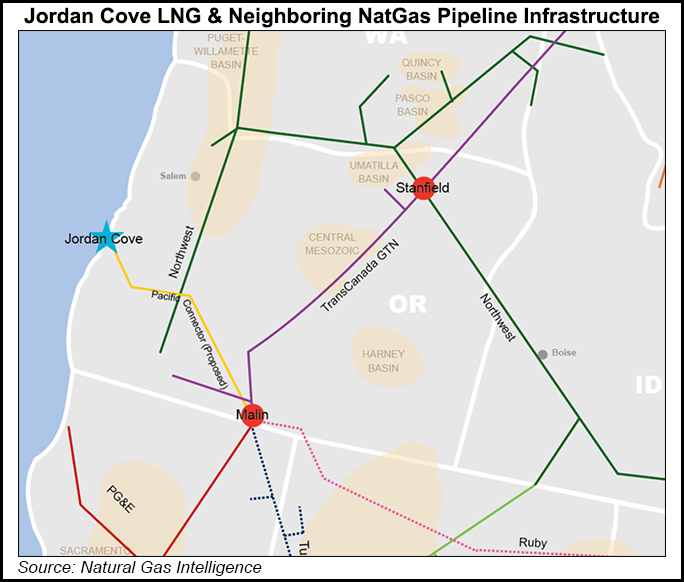Regulatory | Infrastructure | LNG | LNG Insight | NGI All News Access | NGI The Weekly Gas Market Report
FERC Staff Issues FEIS for Jordan Cove LNG Project
FERC staff has issued a long-awaited final environmental impact statement (FEIS) for the Jordan Cove liquefied natural gas (LNG) project and the associated Pacific Connector gas pipeline project in Coos County, OR.

The Jordan Cove LNG project, capable of liquefying up to 1.04 Bcf/d for export, would include a pipeline gas conditioning facility, five liquefaction trains, two full-containment LNG storage tanks and associated equipment, an LNG loading platform and transfer line, marine facilities, and associated facilities [CP17-494, CP17-495]. As proposed, the LNG terminal would handle about 120 LNG carriers per year.
The pipeline would originate at interconnections with existing pipeline systems in Klamath County, OR, and would span parts of the state’s Klamath, Jackson, Douglas, and Coos counties before connecting with the terminal. The nearly 229-mile, 36-inch-diameter pipeline would be capable of transporting up to 1.2 Bcf/d.
Jordan Cove would be the first natural gas export facility sited on the U.S. West Coast.
Many environmental impacts to construct and operate the project “would not be significant or would be reduced to less than significant levels” through mitigation measures, however, some impacts would be “adverse and significant,” according to the FEIS, which was released late Friday.
Specifically, Federal Energy Regulatory Commission staff found that building the project would temporarily impact housing in Coos Bay and permanently impact the visual character of Coos Bay. Noise resulting from pile driving activities at the LNG terminal would temporarily impact the area. The project could also impact the Southwest Oregon Regional Airport operations and is likely to adversely affect 18 federally listed or proposed threatened/endangered species, staff said.
FERC staff recommended that the impact avoidance, minimization and mitigation measures included in the FEIS be attached as conditions to any certificate issued by the Commission for the project.
The project has cleared several regulatory hurdles and faced fierce opposition from environmental groups since it was proposed by Veresen Inc., now part of Pembina Pipeline Corp. FERC rejected an application for the project in March 2016, citing problems with its Pacific Connector pipeline link to tap Western Canada and U.S. Rockies supplies, along with a lack of contracts from buyers. The application was refiled in September 2017.
Earlier this year, FERC said a 35-day partial shutdown of the federal government forced it to delay by more than 40 days completion of the Jordan Cove LNG EIS. Last month, the EIS was again delayed, this time when the U.S. Forest Service “received critical information from the project proponent that is necessary for it to complete its land and resource management plan amendments,” FERC said. The agency expects a final order by Feb. 13.
Calgary-based Pembina has said that while it still viewed the project as “viable,” it will limit capital investments for anything not related to permitting ahead of making a final investment decision. Pembina approved $50 million in incremental funding for 2019 “in support of the remaining critical regulatory and permitting work streams.”
The project must still obtain permit approvals in Oregon. In May, the Oregon Department of Environmental Quality denied a water quality certificate and said approval may only be granted if a new application assures full compliance with state construction standards.
Environmental groups remain opposed to Jordan Cove, claiming it would be supplied by shale and tight gas resources, which are produced using horizontal drilling and hydraulic fracturing (fracking).
“FERC was right to reject this dirty fracked gas facility in 2016, and nothing has changed since then,” said Sierra Club senior attorney Nathan Matthews. “This project remains a threat to clean water and the climate, and it should never be built.”
© 2024 Natural Gas Intelligence. All rights reserved.
ISSN © 1532-1231 | ISSN © 2577-9877 | ISSN © 1532-1266 |
